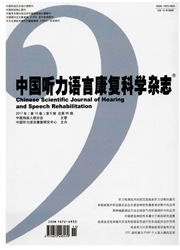

 中文摘要:
中文摘要:
目的探讨圆窗入路人工耳蜗植入术后患者残余听力的变化。方法回顾性分析北京友谊医院2012年10月至2014年7月能够配合纯音测听的11例患者接受奥地利MED—ELSONATA标准电极人工耳蜗植入术后植入侧残余听力的变化。结果植入侧术后残余听力保留率为72.7%;植入No.5、1、2、4kHz术后听力下降,术后残余听力的变化具有统计学意义(P〈0.05),但0.25、8kHz的残余听力变化均无统计学意义(P〉0.05);术后植入侧残余听力以4kHz损失最明显,不同频率之间无显著性差异(P〉0.05);植入侧各个频率术后听力损失的变化范围较大,说明个体之间残余听力损失情况差别较大。结论圆窗入路人工耳蜗植入术后植入侧的残余听力有不同程度的损失,而部分有所保留;不同频率的听力损失不同且个体间差异较大。
 英文摘要:
英文摘要:
Objective To study the residual hearing of patients after cochlear implantation via the round window membrane at several different frequencies. Methods Preoperative and postoperative pure-tone audiometry (PTA) were performed for 11MED-EL SONATA recipients who had measurable residual hearing before implantation from October 2012 to July 2014. Results Among the 11 cochlear implant recipients,8 had preserved measurable hearing (72.7%) but the other 3 recipients had lost all measurable hearing after implantation on the implanted side. The thresholds of the implanted ears dropped significantly at 0.5, 1, 2 and 4 kHz(P〈0.05), but there were no significant changes at 0.25 and 8 kHz (P〉0.05). The changes of residual hearing was the most significant at 4 kHz. There was no significant difference between different frequencies (P〉0.05). The ranges of residual hearing changes at all frequencies after cochlear implantation were relatively large, indicating notable individual differences. Conclusion The recipients have different degrees of hearing loss after cochlear implantation via the round window membrane, but some preserve the residual hearing. The changes of residual hearing are different among different frequencies and individuals.
 同期刊论文项目
同期刊论文项目
 同项目期刊论文
同项目期刊论文
 期刊信息
期刊信息
